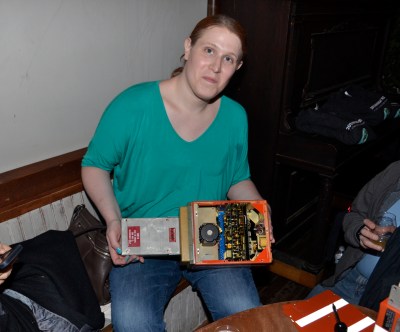Our New York City trip for the TechCrunch hackathon is just about wrapped up, and this weekend we’re hosting a hardware hackathon at the Hackaday Design Lab in Pasadena, but there’s still one more event from NYC left to cover: our drink-up in the city.
Our drink-up took over about 90% of the Antler Beer and Wine Dispensary, with the usual, not electronically enabled patrons sufficiently annoyed.
 While this meetup was really just a meet-and-greet pregame for the TechCrunch hackathon, and not a proper ‘bring a hack’, that didn’t stop a few people from toting out some very cool hardware. [Katie Fortunato] trucked out a flight data recorder (or an airplane’s black box, painted orange for visibility) that is supposedly from a 747.
While this meetup was really just a meet-and-greet pregame for the TechCrunch hackathon, and not a proper ‘bring a hack’, that didn’t stop a few people from toting out some very cool hardware. [Katie Fortunato] trucked out a flight data recorder (or an airplane’s black box, painted orange for visibility) that is supposedly from a 747.
This flight data recorder keeps relevant data on a loop of mylar tape. We didn’t crack into that part of the black box, but we did manage to dig into the electronics. Very weird stuff in there; the control electronics have a backplane design, where each card has a connector that’s basically 2 rows of 50 or 75 female pin sockets. These cards aren’t keyed in any way, and they must be placed in the backplane in a certain order. The circuits are extremely simple; just a mix of op-amps, 74- and 54-series logic (no, we can’t figure that one out, either), buffers, and inverters. The latest date code was some time in the early 80s, and all the boards had a conformal coating on them. There’s a weird connector on the outside of the black box [Katie] promises to document on her hackaday.io profile.
Also at the event were a few folks from NYC Resistor, a few people from the IoTGotham meetup, some of the crew from littleBits. Somewhere in the pictures below is a Ms. PacMan/Galaga cabinet. Yes, I tested the bee overflow cheat, it works, but the high score was above 500,000.
























“74- and 54-series logic (no, we can’t figure that one out, either)”
Yea that’s a good question. The only reason I can think of might be because there were redundant circuits, and the 54 series logic was only used in the fall over circuit due to the added cost. That, or maybe the 54xx series logic has the ability to sink more current on it’s outputs. I used to have a 4 inch thick Signetics 74/54xx data book from 1978 that had some 54xx parts listed with increased input and output tolerance when compared to their 74xx counter-part, but then it’s been 20 years since I read that so I might not be remembering correctly. If that is the case, though, maybe by circuit design some parts were under more stress than others and the 74xx logic was within tolerances for some parts, but not others.
Just a thought…
My life is complete. Getting a mention on HaD’s front page makes me a very happy cat. :D
For those wondering, the FDR is a Lockheed Aeronautical Systems Model 209(e). I haven’t found much in the way of documentation on it, and with it requiring 115v at 400Hz, I’m not about to start fscking with pinouts until I get some more detail. I have put in an email to Lockheed to see if they might have a digitized copy available for me, but so far no dice. If anyone does find some, let me know.
My ultimate goal is to be able to read back the data that’s stored in it, and see if I can’t then decode that – possibly with a little help from the NTSB. After that, I may try recording dummy data back onto it. Then who knows.
Anyway, I’m glad the HaD folks got as much of a kick out of it as I did.
Interesting side note: “Trucking out” is probably the most accurate description of what that was – that sucker is 22.5 lbs of steel and circuitry. Remember, these babies are designed to survive a plane crash, and above all, protect the storage medium.
Interestingly, this unit is originally from Northwest Airlines.
Get a pic of the connector up. I’m out in LA and just picked up a Tek 212 oscilloscope today. I’d like another reason to head out there again.
Will do, Brian!!! :) This actually made me realize that even if I can’t yet do any work on the device, I certainly can pull it open and start photo-documenting it for the HaD crowd. One day I might take it into Resistor too to see what people think of it, and come up with some ideas.